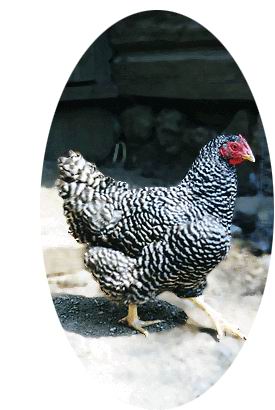Chicken - American Dominique
Domestic Chicken, Dominique Chicken, Dominiker Scientific Name: Gallus domesticus
Sat, 12th July, 2025 - 3:58 am GMT
Sponsor Ads:

Alternative Name
Domestic Chicken, Dominique Chicken, Dominiker Scientific Name: Gallus domesticusBasic Info
The Dominique Chicken is well known for its rose colored comb. It has black and white barred plumage, and wattles that are bright red on the head and face. They have a heavy plumage, which has been used for down in feather beds and pillows. These chickens are medium sized. The cocks are seven pounds, the cockerels are six pounds, the hens are five pounds, and the pullets are four pounds. Dominique Chickens mature at a young age and hatch easily. These chickens are also known for their ability to scratch for food and survive in un-ideal conditions. They can also breed in these conditions, making them ideal chickens for farming. Dominique Chickens are seen in both the standard size and bantam varieties.
Health
These chickens are fairly easy to take care of and will scratch for their food, making them more manageable than some other varieties. It is, of course, always best to provide them with food. They eat a mixture of grains, sunflower seeds, and laying pellets. During the cold winter, they need to be kept inside a barn.Habitat
N/ABehavior
The Dominique Chicken is not only beautiful, with its rose colored comb, but it can be used for dual purposes. While not widespread today, the Dominique was once a common domestic chicken, and it has become a part of American folklore. The Dominique Chicken, also known as the American Dominique, is very calm. Most hens have a tendency to be brooding, but not the Dominique. They are an exceptionally hearty breed, and can produce eggs even if kept in marginal conditions. This may account for their popularity in the past. They make good birds for show, as well as for other general purposes. Dominique Chickens are very adaptable. They can be outside in the wild, they can be in chicken coops, or they can be in barns during the winter when it is cold. Chicken coops are probably suited best for them, because they will have room to walk around and still be protected from predators. Dominique Chickens are also very useful; they can be used for their brownish colored eggs and for the meat that they provide.Origin
United StatesHistory
Columbus brought the first domestic chickens to America in 1493. The Dominique Chicken might well be the first chicken bred in America. Rose comb barred chickens were officially called Dominique in 1849. Prior to this time there was often some confusion between the Dominique and the Plymouth Rock chickens. Settlers were very intrigued by the chickens, because of their versatility, and they became an economic necessity. Books soon came out to serve as a guide to help the farmers breed them properly. One was called the American Standard of Perfection, and The American Poultry Association put it out. The interest in the Dominique chickens declined as people found new and "improved" chickens. In time, the Dominique became in danger of extinction. Efforts are being made to keep the Dominique chicken intact, and it is because of organizations like the American Poultry Association that the chickens are on the rise, population wise. It is important to maintain these older breeds, as their unique traits, genetic diversity, and heartiness are important to the poultry industry, as well as to fanciers. Today, they are still listed as critical by the American Livestock Breeds Conservancy. Some zoos are also playing an active role in keeping some of these heritage breeds in existence.Common Foods
N/ASponsor Ads:
"Never argue with idiots, they'll only drag you down to their level and beat you with experience."
Chicken - American Dominique
Coded by: BGID® | ALL RIGHTS RESERVED Copyright © 2000-2025
Disclaimer | Privacy | Report Errors / Contact | Credits








 Why haven't we as a collective earth met with aliens yet?
Why haven't we as a collective earth met with aliens yet?  World EcoSystem - Biodiversity Changes - Who is on board and who isn
World EcoSystem - Biodiversity Changes - Who is on board and who isn  Homosexual behavior stems from the mind or genetics?
Homosexual behavior stems from the mind or genetics?  The Best Text Adventure You Will Ever Play! The official site:
The Best Text Adventure You Will Ever Play! The official site:  Mouthwash - Mouthrinse - Mouth Sores - Healing Infections - Gingivitis
Mouthwash - Mouthrinse - Mouth Sores - Healing Infections - Gingivitis  Treatment for Depression
Treatment for Depression  Ultra radical and violent Islamist group that even rivals Al Qaeda
Ultra radical and violent Islamist group that even rivals Al Qaeda  An idea to have teachers who want to carry guns to school undergo some level of police training will be left up to local school districts and police departments.
An idea to have teachers who want to carry guns to school undergo some level of police training will be left up to local school districts and police departments.